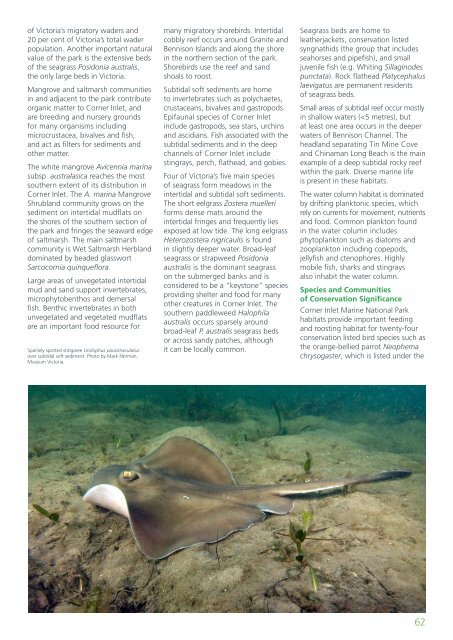Marine Natural Values Study Summary - Parks Victoria
Marine Natural Values Study Summary - Parks Victoria
Marine Natural Values Study Summary - Parks Victoria
You also want an ePaper? Increase the reach of your titles
YUMPU automatically turns print PDFs into web optimized ePapers that Google loves.
of <strong>Victoria</strong>’s migratory waders and20 per cent of <strong>Victoria</strong>’s total waderpopulation. Another important naturalvalue of the park is the extensive bedsof the seagrass Posidonia australis,the only large beds in <strong>Victoria</strong>.Mangrove and saltmarsh communitiesin and adjacent to the park contributeorganic matter to Corner Inlet, andare breeding and nursery groundsfor many organisms includingmicrocrustacea, bivalves and fish,and act as filters for sediments andother matter.The white mangrove Avicennia marinasubsp. australasica reaches the mostsouthern extent of its distribution inCorner Inlet. The A. marina MangroveShrubland community grows on thesediment on intertidal mudflats onthe shores of the southern section ofthe park and fringes the seaward edgeof saltmarsh. The main saltmarshcommunity is Wet Saltmarsh Herblanddominated by beaded glasswortSarcocornia quinqueflora.Large areas of unvegetated intertidalmud and sand support invertebrates,microphytobenthos and demersalfish. Benthic invertebrates in bothunvegetated and vegetated mudflatsare an important food resource forSparsely spotted stingaree Urolophus paucimaculatusover subtidal soft sediment. Photo by Mark Norman,Museum <strong>Victoria</strong>.many migratory shorebirds. Intertidalcobbly reef occurs around Granite andBennison Islands and along the shorein the northern section of the park.Shorebirds use the reef and sandshoals to roost.Subtidal soft sediments are hometo invertebrates such as polychaetes,crustaceans, bivalves and gastropods.Epifaunal species of Corner Inletinclude gastropods, sea stars, urchinsand ascidians. Fish associated with thesubtidal sediments and in the deepchannels of Corner Inlet includestingrays, perch, flathead, and gobies.Four of <strong>Victoria</strong>’s five main speciesof seagrass form meadows in theintertidal and subtidal soft sediments.The short eelgrass Zostera muelleriforms dense mats around theintertidal fringes and frequently liesexposed at low tide. The long eelgrassHeterozostera nigricaulis is foundin slightly deeper water. Broad-leafseagrass or strapweed Posidoniaaustralis is the dominant seagrasson the submerged banks and isconsidered to be a “keystone” speciesproviding shelter and food for manyother creatures in Corner Inlet. Thesouthern paddleweed Halophilaaustralis occurs sparsely aroundbroad-leaf P. australis seagrass bedsor across sandy patches, althoughit can be locally common.Seagrass beds are home toleatherjackets, conservation listedsyngnathids (the group that includesseahorses and pipefish), and smalljuvenile fish (e.g. Whiting Sillaginodespunctata). Rock flathead Platycephaluslaevigatus are permanent residentsof seagrass beds.Small areas of subtidal reef occur mostlyin shallow waters (
















